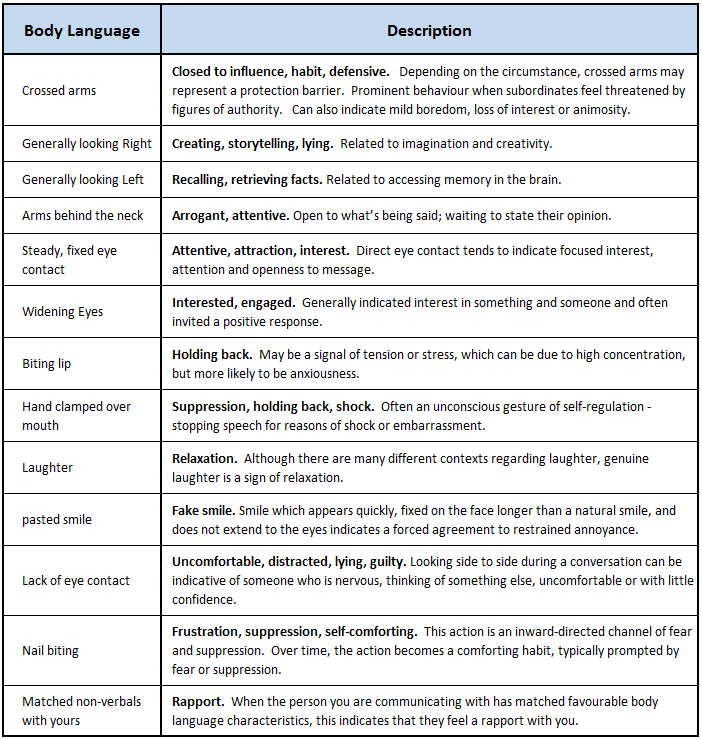Training Consultants: Effective Communication – Part 2

Our last blog titled “Training Consultants Top 4 Tips on Active Listening” received a flurry of
questions, comments and attention. So much that we decided to publish a second blog touching on another important element of effective communication – body language.
Body language, technically referred to as kinesics, is a significant aspect of relationship building and communication. It is particularly relevant among the corporate environment and a powerful concept which is widely understood by successful people.
According to our leadership development consultants, nonverbal body language and active listening are the facilitating cornerstones of effective communication. As a receiver or listener, we must open our minds to the meaning of what, why and how others are communicating to us.
Below, we will point out tips on how to interpret body language in various forms, including universal facial expressions, common body language interpretations and dangers of making assumptions.
Body Language
Body language is very influential in forming impressions when first meeting someone. We form our opinions of someone we meet for the first time in just a few seconds, and this initial instinctual assessment is based far more on what we see and feel about the other person than on the words they speak. On many occasions we form a strong view about a new person before they speak a single word.
Communications training consultant experts estimate that only 7% of our communication is represented by the words we use, 38% by voice quality and how we say those words and 55% by our nonverbal and body language.

Facial Expression
Our training consultants state that there are six basic facial expressions of human emotion that are recognized around the world - and that the use and recognition of these expressions is genetically inherited rather than socially conditioned or learned.
While there have been found to be minor variations and differences among cultures, the following human emotions are generally used, recognized, and apart of humankind's genetic character.
These emotional face expressions are:
• Happiness
• Sadness
• Fear
• Disgust
• Surprise
• Anger
Common Body Language Interpretations

What is the danger of making assumptions about the meaning of nonverbal cues?
Our leadership development consultants state that, as we interact with others, we continuously give and receive wordless signals. From the way we sit, to how fast or loud we talk, to how close we stand – everything we do sends strong messages to the receiver of communication. Almost always, we interpret these nonverbal behaviors to mean something.
Before making assumptions based on a few nonverbal characteristics, however, be aware that nonverbal behavior varies from person to person, culture to culture, and may have different meanings.
For example, many believe a firm handshake indicates a strong personality while a weak handshake is interpreted as a lack of fortitude. This is not always the case. Someone may have a feeble handshake due to a physical alignment, like arthritis for example.
Someone with crossed arms might be keeping warm, rather than being defensive. Depending on the culture, a lowered head represents a sign of respect rather than someone who is shy, ashamed or not confident.
Always remember to look for clusters of behavior. They are far more reliable than individual elements. When we pay attention to the details and nuances of nonverbal behaviors or cues, we improve our ability to detect the true meaning of the speaker’s message.
Our training consultants state that, as a communicator and leader, it is important to think about your intended message. Imagine yourself in front of a mirror. Are your nonverbal messages consistent with your intended message? Are you demonstrating open communication postures and tones to let the other person know that you are open to two-way communication?
When you are doing the talking, recognize that nonverbal cues can tell you when you have talked long enough, when the other person wants to speak, and the mood of others and their reaction to your message. Pay attention to others’ nonverbal reactions as you speak and you will be a better leader, speaker, and influencer.
